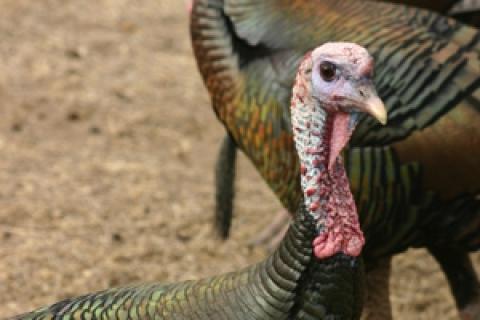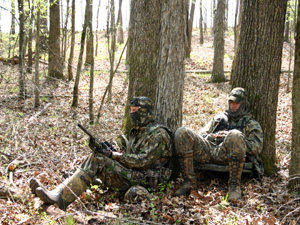
The sound — or lack of sounds — was frustrating to say the least. A gobbler that I had in my sights roosted the evening before had simply glanced around him in the faint morning's daylight, and then he stepped off the thick limb where he was perched. On outstretched wings that silent gobbler glided over to mingle with a large flock of turkey hens that were flying down from roosts and gathering on a distant hillside. My best soft yelps and hen talk had been completely ignored. I'd been stood up by a gobbler that did not gobble.

More and more turkey hunters are meeting — and taking on — gobblers that don't gobble. The talkative ones have been removed from the turkey gene pool and are now decorative fan mounts in hunters' homes. The gobblers that have kept their bills shut and their heads down have lived long and grown gray beards. They definitely don't have much to say. And there seems to be more gobblers that don't want to make as much as a peep in the fields and forests these days.
All, however, is not lost.
You can learn to take on these silent gobblers and reduce one to the task of filling the big pocket on the back of your hunting vest if you know how to play the new turkey hunting game. You'll call and move less often to get your gobbler. And you'll have to rethink your approach to turkey hunting as you leave the calls in your vest pockets more often.
Gobblers often go silent due to one important factor: hunting pressure. In many cases the bird has evaded a swarm of near deadly hunters' shot that erupted from a shotgun at close range. The last thing you want to do now to reduce that turkey to possession is call and act like other hunters.

Custom Box Turkey Call
Tip Watch Video: Hide Your Face From Wary Gobblers
You've Got to Talk Like a Lady Turkey!
Gobblers in spring are focused on one thing — finding hens. Those gobblers pause often to listen for the sounds of active hens. Even strutting gobblers are prone to drop from the strut, stand erect, and listen and observe. If hens are what they want, then you should work hard to sound like a hen. And carry several turkey calls so you can sound like young, old and many hens.

After you've spotted and heard hens in your hunting area, move as close as you can to the flock, settle in, and start calling and squawking. The best way to turn a group of clucking hens in your direction is to mock and mimic the lead hen. Anything that old raspy matriarch says, you try to repeat it and then go one up. Soon you'll find she'll be headed your way to peck you into place, and any gobbler with the flock will be certain to follow.
You'll know you're on the right calling track when a hen in the group becomes more and more talkative and fussily yelps what seems like nonstop, irritated clucking. She's telling you to shut up. Just toss every cluck back at her with aggressive overtones, and get your shotgun up.
You can also use many calls to sound like a large group of hens. If you have partners hunting with you, have them sound like as many hens as possible. Get as many hen calls producing hen chatter as is possible at one time. The object is to sound larger than any nearby turkey flocks, and declare turf war. Again, any gobblers with the real things will be coming along to see a hen brawl. Be ready and you won't be disappointed.

Hen Turkey Call Combo
And one call that seals the deal with many feeding turkey flocks is when you reach beside you with a gloved hand and noisily rake the leaves to mimic a hen — or many hens — scratching and feeding. Turkeys have home ranges, and they hate to have invaders stealing their grub. When they come to confront you there could be a silent gobbler in the group.
If you've scouted well and know that there are turkeys in the area, or have heard them clucking nearby, talk to them. Concentrate on winning — or whining — the hens nearer, and they'll bring the gobbler along.
Tip Read: Keep Your Turkey Calls Simple
Be Quiet, O'Hunter & Call Only Once

Lounger Vest for Men
Another tactic after you hear a gobbler gobble once, or spot one, is to call only once. Then grab a seat and drop that call onto the ground or into a turkey vest pocket. The silent treatment on gobblers seems to get the best of them. You simply sound off and go silent after you've moved in as close as possible. More times than not I've had the group — hens and a gobbler — come looking for me, and often the gobbler that generally drags along behind is now leading the parade.
Granted this tactic involves sitting comfortably for a long period of time, and being ready to take on a gobbler that is prone to just walk right up and look you in the eye. A keen wild turkey knows the exact location where you called from, and sooner or later they'll come there to meet you. Just be very patient.
Turkey Hunters, You Must Get Comfortable

One of the main reasons that many hunters run out of patience is that they become too uncomfortable and unable to sit motionless for long periods of time. You owe it to yourself and your hunting success to be comfortable. Think of how often you've called and moved, and then later heard a turkey or gobbler at the location you just vacated. "Should have stayed in place longer," you wish. Turkeys move slow (except when flying); think of a strutting gobbler's dragging wings as parking brakes. He's on the way; it's just going to take him time to get there. You need to sit, wait and wait some more.

Over Glass Friction Turkey Call
Tip: In order to sound like a large group of hens, use multiple turkey calls or recruit a hunting partner
In the effort to get comfortable, I've seen more and more hunters using the small webbed seat with 5- or 6-inch long legs. Combine a comfortable seat with a vest complete with a padded back and your main problem now could be staying awake. The good news is that seats get you up and off of roots, rocks, cacti, wet and cold ground, and other things hunters are not designed to sit on comfortably. A seat also gives you added inches of increased sight that translates into more terrain viewed down range.
Get comfortable and in a position to shoot in many areas around you. Often hunters sit in a location or back into dense brush where they could not shoot at anything. Once you sit down, look for lanes, shoulder your shotgun, and swing it around to check for obstacles like limbs and tree trunks. The items could be closer than you think.
An added item that can increase your comfort is a bottle or canteen of water. Many hunters get fatigued and give up the hunt without realizing that they're actually thirsty, not tired. Hydrating can keep you on the move and on the hunt. Drink up, and sit down.
Tip: Click to see a printable version of the 15 Turkey Vest Essentials Checklist.
What to do When the Gobbler is Off to the Side of the Flock
When calling hens with the intention of getting a silent gobbler to follow, you should note that sometimes the gobbler stays off to the side of the flock. This can put him in a position where you can't shoot if you shoulder and shoot right-handed. Each time you pattern a shotgun, use a few shotshells to practice shooting with the off-hand. Once you fire a few shots and build experience and confidence in shooting with the weak side, any gobbler within reasonable range becomes a meal. With practice, you'll be prepared in case a gobbler steps in at the seemingly wrong spot. Just switch sides, align the sights, tug the trigger and notch your turkey tag.
Watch Video: Turkey Hunt: 7 Tips to Pattern Perfection
- 20779 views

